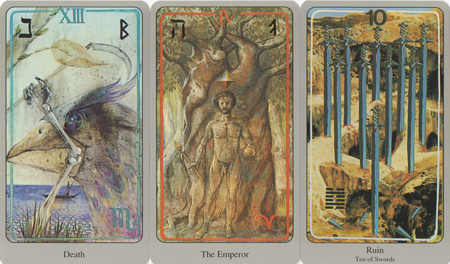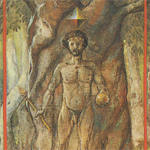By Sarah Taylor
As you can see, this week I’m using a different tarot deck, thanks to leaving three of my Röhrig cards in a scanner at my partner’s house. I’m taking it as a deliberate mistake, and that the Weekend Tarot Reading wanted to cross the threshold between the old year and the new with an emphasis on something ending, and something beginning.
And I have no doubt about that when I look at the three cards in front of us.

Death, The Emperor, Ten of Swords from the Haindl Tarot deck, created by Hermann Haindl. Click on the image for a larger version.
The cards themselves come from the Haindl Tarot, a deck created by the late German artist Hermann Haindl. (Interestingly, The Röhrig Tarot that I usually work with is also named after its creator, Carl Röhrig, who is also a German artist.) I was fortunate enough to do a reading for Mr Haindl back in 2012. I didn’t fully appreciate who he was at the time, which was probably a good thing given the pressure of coming up with a spontaneous 60-second interpretation of the card he was holding out to me. I searched out his deck after that, but I wasn’t drawn to it then. Today, I was.
The Haindl deck is generally considered advanced tarot-reading material. I’m not sure that’s to do with the cards themselves as much as people’s response to them. Haindl uses a lot of contoured hatching in his illustrations, and this gives the cards a shadowy depth — as if there is layer upon layer. He also uses pagan, Ancient Egyptian, and Native American imagery, so some of it is unfamiliar, at a cultural remove to many readers.
I think the imagery is striking, and has a sensate clarity to it — if you can get past any judgments that tell you you’re not up to feeling it. The images are less stylised; they may feel a little sobering.
Perhaps that’s entirely supportive for a reading that is interested in showing you what is falling away, and — and this is important — what remains and continues because it holds integrity.
On Dec. 6, the Ten of Swords appeared in the same position it does here. It’s entirely possible that what’s going on now is a continuation of a theme that you identified back then. This time, the Ten’s companions are The Emperor, at centre, and Death, on the left. I drew The Emperor first. Although he represents a pure archetype — the secular ruler — he is also the only card of the three that has a person as the protagonist (if you exclude the bony arm in Death). He’s also facing us head-on.
So in this case, you are The Emperor — or more accurately The Emperor is an archetype that is active in you. And you, as The Emperor, are flanked and influenced by — and are influencing — two experiences: Death and the Ten of Swords.
Some of the ways the cards are ‘talking’ to each other drew my interest immediately.
First, the relationship between Death and The Emperor. These two correspond with each other numerologically, the 1 and the 3 of the 13 in Death adding up to the 4 of The Emperor. They are complementary. How? As ruler of the human realm, The Emperor is interested in secular (i.e. non-religious) law and how it is expressed and enforced. When this archetype is in balance, he ensures our human outer and inner realms remain accountable to themselves and to the natural world, which is ruled by his counterpart The Empress.
Here, The Emperor knows he has no clothes. He doesn’t need them! There is no guile, no need to embellish his power, which is in alignment with natural law — hence the tree behind him.
Both Emperor and Empress understand the cycles of life — that all things are born, live, die, and are reborn, time and again. More than that: death makes way for life; from death emerges renewal. Look at the sceptre that The Emperor holds, then look at the skeletal forearm holding the scythe in Death. They mirror each other. From the bones comes a wheat-sheafed symbol of power that is to the living truth of things what the hand in Death is to its polar opposite.
The raven looks away from The Emperor and off to the distant left. Something has happened in the recent past that marks an ending. It was time. And there’s no going back to the way things were, no resurrection of the form it was in. As painful as it might have felt, and perhaps as sudden, there was a stripping away and, with it, a completion.
Well, actually, not quite. Not a completion; a transition. Because what remains standing, facing us, at centre, is The Emperor. His nakedness now takes on a new meaning in light of Death. Maybe it was his clothes that were stripped away? His perceived source of protection; his armour; his defences; his insistence on demonstrating his leadership through appearances rather than holding himself to the truth of his calling.
Maybe he gave up the pretence.
To his right, another correspondence makes itself clear: the small ball and cross-bar of the central sword’s hilt in the Ten of Swords is reflected in the eye of the raven in Death.
“Remember who you are,” it seems to say. “And remember who you thought you were.”
Those caves you hid out in, conveniently running from one shady corner to another to escape the blaze of consciousness?
Those mind-games that have taken up so much time of yours, as you tried to convince yourself in the face of increasingly compelling evidence to the contrary?
All those entrances are barred to you now. There’s nowhere to hide out anymore in this particular matter you’ve been facing down.
Nowhere to run; nowhere to hide.
Why would you want to? You’re The Emperor, for crying out loud! Maybe it’s time to start acting like one. Because what I see now are the colours of the cube above your head also reflected in the eye of the raven. A cube is even, solid, stable. The four directions are indicated in each horizontal vertex, the ‘above’ and ‘below’ in both vertical ones. And there you are, at the centre — of the seven directions and of this reading.
Something that didn’t fit any more has fallen away. You experienced loss? Certainly. You’re raw? Probably. Vulnerable? Yes. But ducking for cover — whether by disappearing (so you elude yourself, too) or by wearing masks — will no longer be a game that serves you particularly well.
You have the capacity to step into a deeper, more responsible integrity. It’s time to start assuming a role of leadership in your own life.
Astrology/Elemental correspondences: Death (Scorpio), The Emperor (Aries), Ten of Swords (Sun in Gemini)
If you want to experiment with tarot cards and don’t have any, we provide a free tarot spread generator using the Celtic Wings spread, which is based on the traditional Celtic Cross spread. This article explains how to use the spread.


I LOVE the Haindl deck. love love love it!